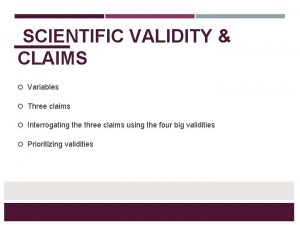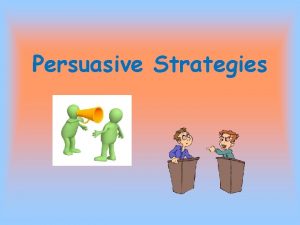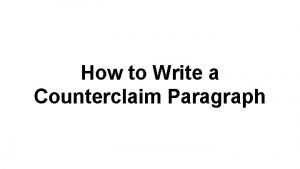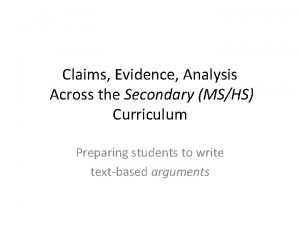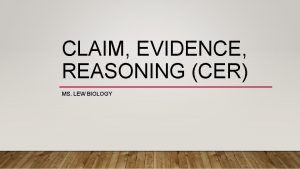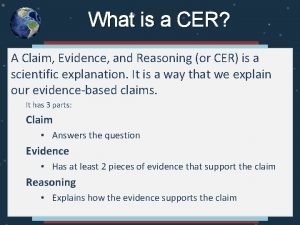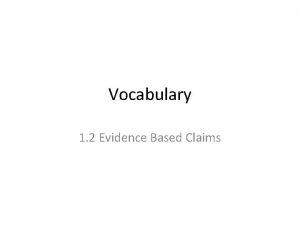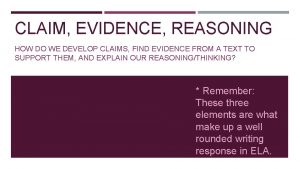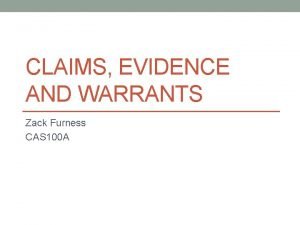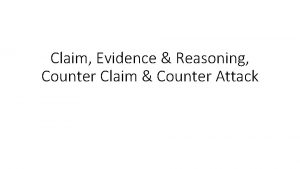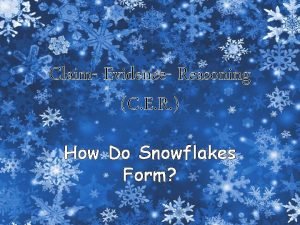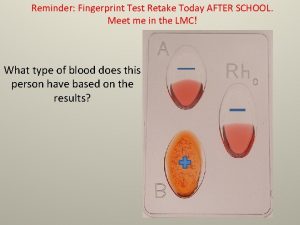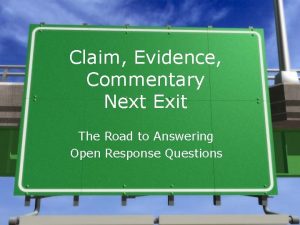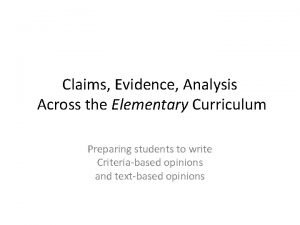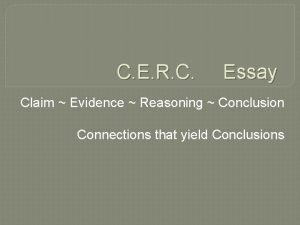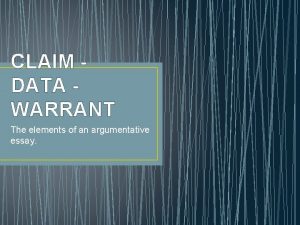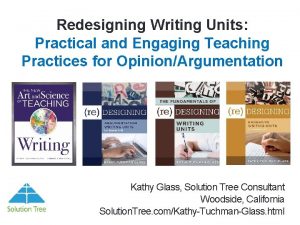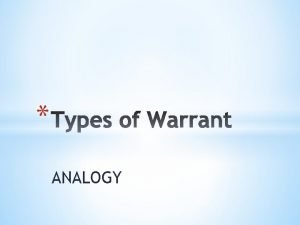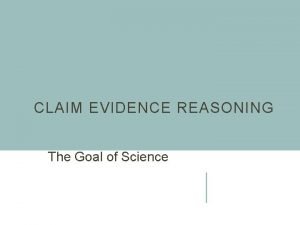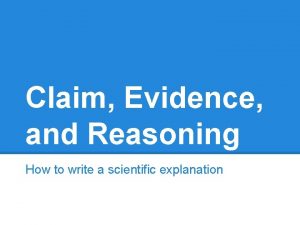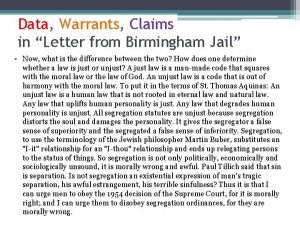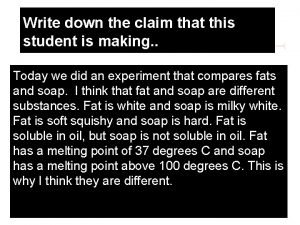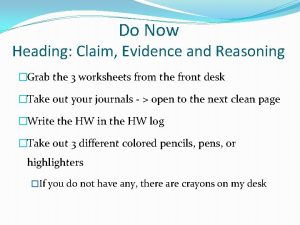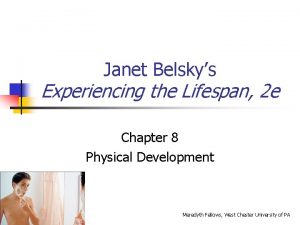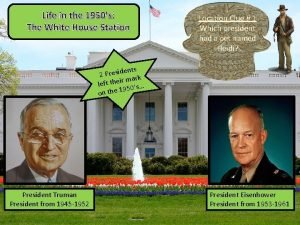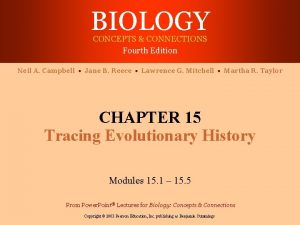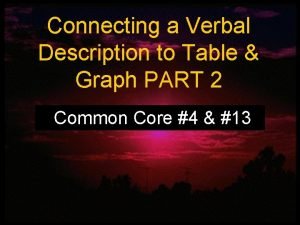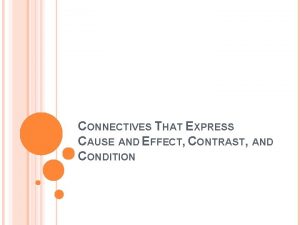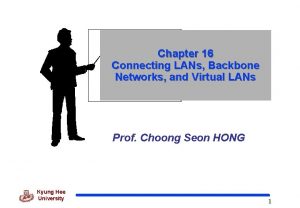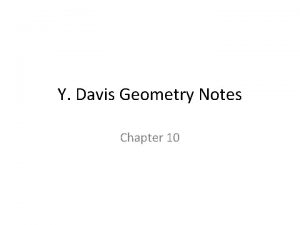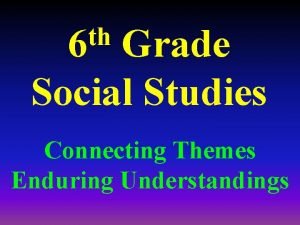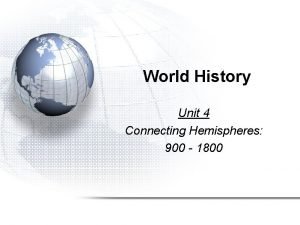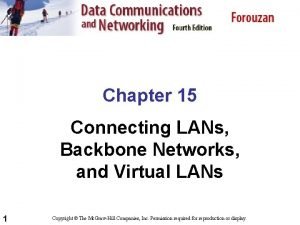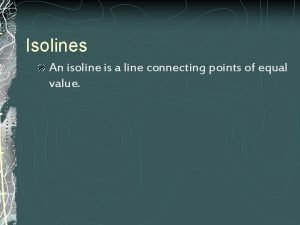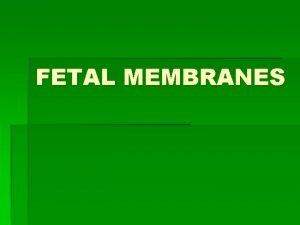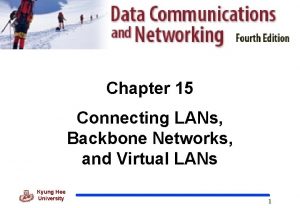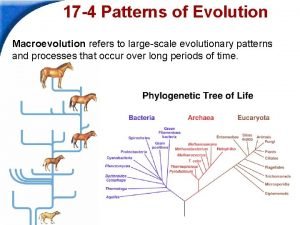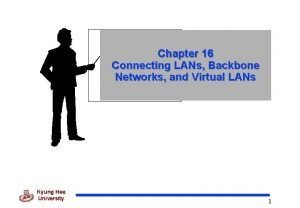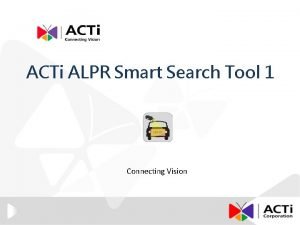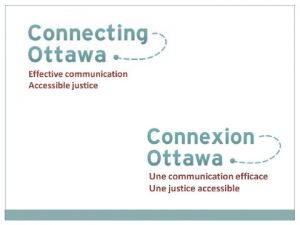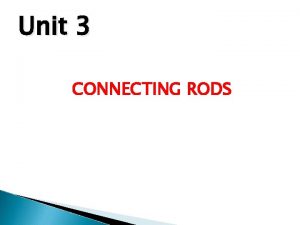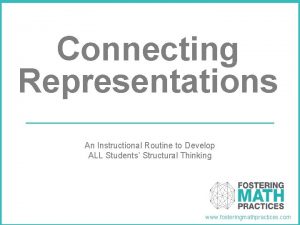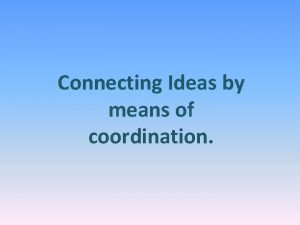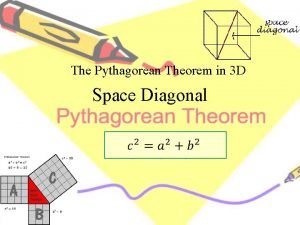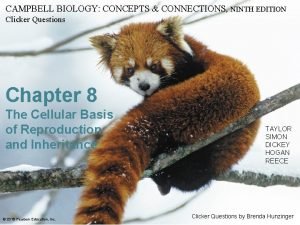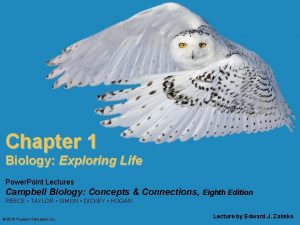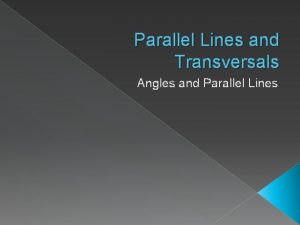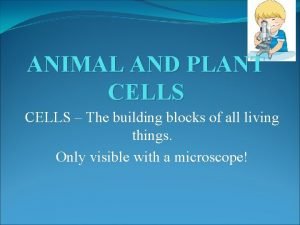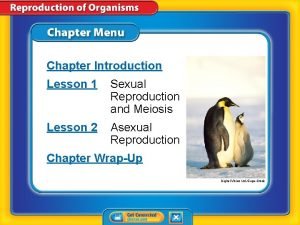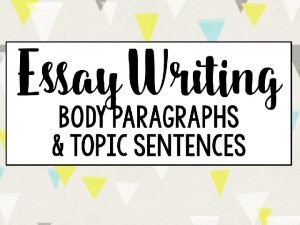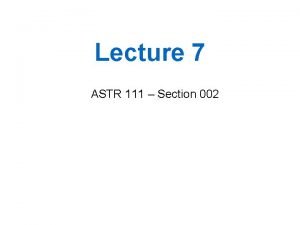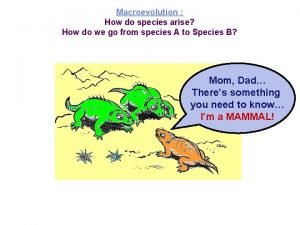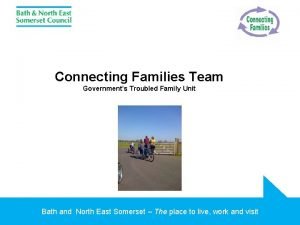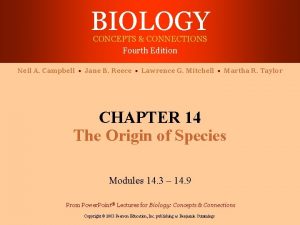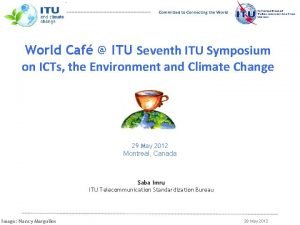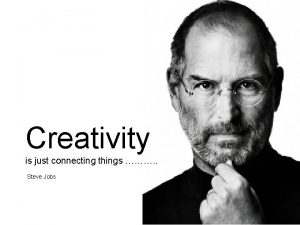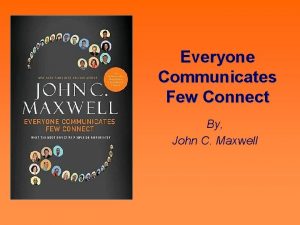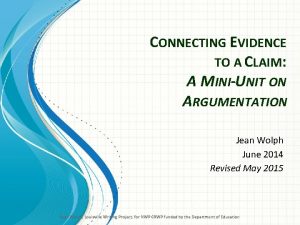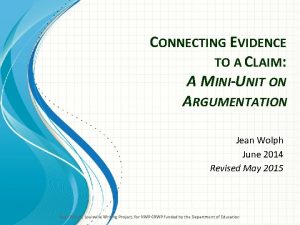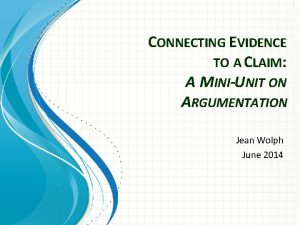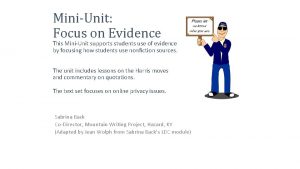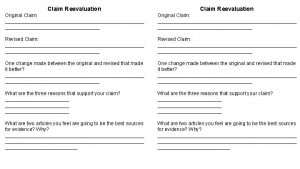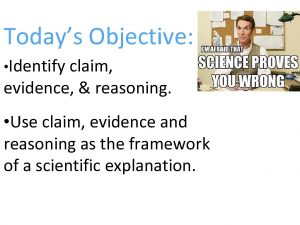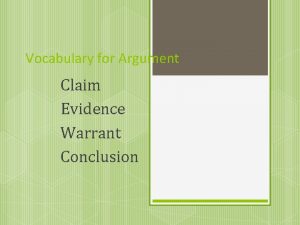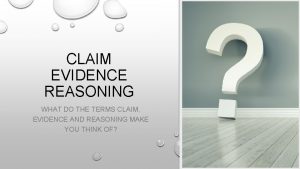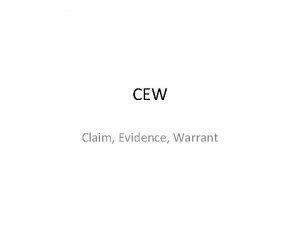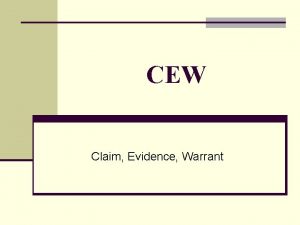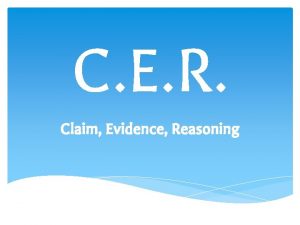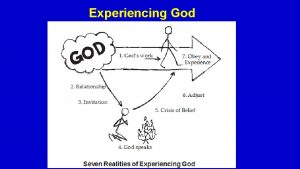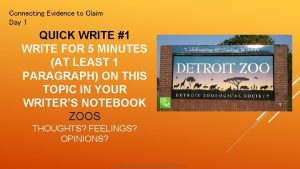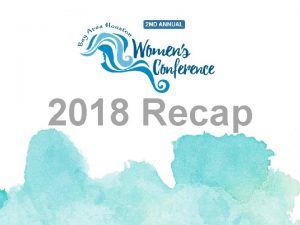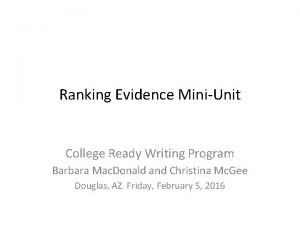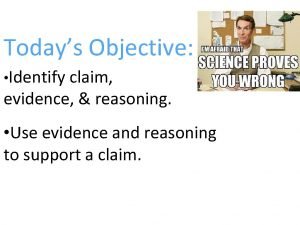EXPERIENCING A MINIUNIT CONNECTING EVIDENCE TO A CLAIM
















































































- Slides: 80

EXPERIENCING A MINI-UNIT CONNECTING EVIDENCE TO A CLAIM Jean Wolph Rev. July 2016 Jean Wolph, Louisville Writing Project, for NWP CRWP funded by the Department of Education

Teacher Slide: Overview Connecting evidence to support a claim is a foundational element of argument writing. In this mini-unit, writers practice revealing their thinking about a piece of evidence in way that makes clear why and how the evidence is relevant to the issue and to the argument the writer is making. Participants read annotate multiple texts, practice connecting evidence, then apply the process while using a student argument planner with their own claims and evidence. *NOTE: Teacher Slides provide detailed explanations and rationale. You can delete or hide them and use the shorter PPT in your classroom.

Teacher Slide: Background A key skill in this set of lessons is to help students do what Joseph Harris calls “forwarding. ” “In forwarding a text, you begin to shift the focus of your readers away from what its author has to say and toward your own project. Writers often describe themselves as drawing on or mining other texts for ideas and examples, but extracting such materials is only part of the job. You then need to shape them to your own purposes in writing. ” (2006, p. 38). The thinking move in this mini-unit is to EXTEND the work of others (in this case, facts and statistics about an issue) to “put your own spin” on the information, connecting it to a local context such as our own school. Countering is also introduced in this mini-unit as a possible “digging deeper” extension of the unit. Harris describes countering as a way of drawing attention to “ideas and phrasings that strike you as somehow mistaken, troubling, or incomplete…. [A]n effective counterstatement must attend closely to the strengths of the position it is responding to, and thus in many ways depends on representing that position clearly and fairly in order to make full sense. The characteristic stance of the counterstatement is ‘Yes, but…’. This sort of rewriting—in which a writer aims less to refute or negate than to rethink or qualify —seems to me one of the key moves in intellectual discourse. ” (2006, p. 6)

Teacher Slide: Decisions Students should be working on a short argument. It can be started DURING this mini-unit using the text set provided, or it can be from any other argument work (Writing into the Day, Informal Arguments, etc. ). This mini-unit is therefore designed to be used with virtually any topic and any text set as it begins after the reading, annotating, and discussion of the texts. If Students Will Be Starting a New Draft: If this mini-unit is taught AFTER students have had some practice in drafting claims and identifying appropriate evidence to support a claim, the exploration of the issue can be done fairly quickly—perhaps in 2 -3 class periods. Strategies learned in other miniunits (such as Informal Arguments) should be used to annotate the texts and identify potential evidence. You can (1) give students a text set to simulate research and have students identify possible evidence from the articles before teaching this lesson (a text set on fast food in schools is included on the next slide but you can easily assemble your own on any topic of interest to your students) OR (2) use these lessons as an addendum to another argument mini-unit. The Overview slide suggests 3 days for the exploration of a text set—videos or images on Day 1, “pro” fast food articles on Day 2, and “con” articles on Day 3. If Students Have a Draft in Progress: Start at Lesson 1, Day 4. The remaining 3 days focus on introducing Harris Moves (illustrating, authorizing, and countering) while students are drafting and revising. That is the part of this mini-unit which could be inserted WHILE you are teaching a different mini-unit. Start with “Lesson 1” after students have read annotated texts for potential evidence to support a claim. Skip Lesson 2 and proceed to Lessons 3 and 4.

Teacher Slide: Mini-Unit Overview Writing Argument MINI-UNIT Emphasis ARGUMENT SKILLS PRODUCT ELEMENTS OF ARGUMENT Reading CLOSE READING STRATEGIES RESPONSE TO READINGS Close reading strategies Writing & talking to develop knowledge on topic or issue TOPICS # of Lessons Draft, Feedback, Revise, Reflect Connect evidence to support claim 4 Lessons plus time to read annotate text set Entering Skills: • Annotating text • Drafting a claim • Identifying evidence (quotations, facts, and statistics) to support the claim Mini-Unit Overview Product: Multi. Claim paragraph draft Evidence with layered returns to revise Use of sources: • Prewriting/ • Illustrating Planning • Authorizing • Flashdraft • Countering using argument Foundational planner Skills: Tying • Feedback evidence to the • Revision claim; explaining its • Reflections relevance Guided evidence analysis 3 -column Argument Planner PQP feedback FAST FOOD 7 shared readings (print ) Digging Deeper: • Authorizing • Countering 5

Teacher Slide: Writing Standards Emphasized in the Mini-Unit Be sure to adapt these to the standards that your district or state uses. Write arguments to support claims with clear reasons and relevant evidence, using valid reasoning. Support claim(s) with clear reasons and relevant evidence…demonstrating an understanding of the topic or text. Conduct short research projects to answer a question, drawing on several sources and refocusing the inquiry when appropriate. Gather relevant information from multiple print and digital sources…and quote or paraphrase the data and conclusions of others while avoiding plagiarism and providing basic bibliographic information for sources. Draw evidence from …informational texts to support analysis, reflection, and research. Write routinely over extended time frames (time for research, reflection, and revision) and shorter time frames (a single sitting or a day or two) for a range of discipline-specific tasks, purposes, and audiences.

Teacher Slide: Suggested Mini-Unit Sequence Before Mini-Unit Days 1 -2 Day 3 Days 4 -5 Students read, annotate, and share/discuss a text set. Study of ways to use sources and connect them to the claim: Illustrating Study of ways to use sources and connect them to the claim: Authorizing Study of ways to use sources and connect them to the claim: Countering Selections from • “A Fast Food Survival Kit” • “The Effects of Fast Food on the Body” • “Healthy Fast Food: Tips for Making Healthier Fast Food Choices” • “America's Top 10 Healthiest Fast Food Restaurants” • “The 19 Ingredients in Mc. Donald’s Fries” Beginning the draft (if students are not using writing from another mini-unit or Writing into the Day experience). PQP Reflecting • “The Effects of Fast Food on the Body” Students form working PQP Reflecting • “Your kids become what you feed them” • “Fast Food Adds 310 Calories to a Teen’s Day” Continuing to draft/revise. Completing the draft.

Teacher Slide: Suggested Text Set for this Mini-Unit • • • A Fast-Food Survival Kit http: //choices. scholastic. com/story/fast-foodsurvival-kit. “Healthy Fast Food: Tips for Making Healthier Fast Food Choices” http: //www. helpguide. org/articles/healthy-eating/healthy-fastfood. htm America's Top 10 Healthiest Fast Food Restaurants (http: //www. health. com/health/article/0, , 20411588, 00. html) The 19 Ingredients in Mc. Donald’s Fries – Including a Form of Silicone Found in Silly Putty Facebookhttp: //naturalsociety. com/19 ingredients-mcdonalds-fries-including-form-silicone-found-silly-putty/ Your Kids Become What You Feed Them http: //sahm. org/healthfitness/your-kids-become-what-you-feed-them-7 -dangers-of-fast-food/ http: //www. healthline. com/health/fast-food-effects-on-body Jean Wolph, Louisville Writing Project, for NWP CRWP funded by the Department of Education

Teacher Slide: Possible Approach to Readings The articles which list multiple examples of the healthy options at various fast food outlets can be used in a “Battle of the Claims. ” Directions follow. Copy the two articles on specific fast food choices (“Healthy Fast Food: Tips for Making Healthier Fast Food Choices” and America's Top 10 Healthiest Fast Food Restaurants), ideally enlarging them a bit so that each segment on a restaurant’s fare can fit on a half sheet of paper. To make a durable class set, copy on cardstock. Give each student or pair of students one of the segments on a particular fast food restaurant, charging them with reading, “digesting” the information, and making a strong claim based on the evidence. For example, “To develop lifelong healthy eating habits, parents should encourage toddlers to try the fruit option at ______ restaurant rather than offering French fries as a side. ” Then the “battle of the claims” begins—each team has a chance to share its claim. Others can challenge the claim if they have conflicting evidence OR offer suggestions for revision if the claim does not reflect the qualities of a strong claim (see separate Power. Point, “What is a Claim? ”).

In this mini-unit, we’ll practice ways that writers use sources to develop their arguments: Illustrating | Using specific examples from the text to support the claim Authorizing | Referring to an “expert” to support the claim Countering | “Pushing back” against the text in some way (e. g. , disagree with it, challenge something it says, or interpret it differently) Jean Wolph, Louisville Writing Project, for NWP CRWP funded by the Department of Education

What You’ll Do First: • Read, annotate, & discuss the text set. • Draft a claim related to this issue that you would like to defend. • Identify evidence that will help you support that claim. Jean Wolph, Louisville Writing Project, for NWP CRWP funded by the Department of Education

Teacher Slide: Teaching the Harris Moves Before this lesson, it will be helpful to have students highlight possible evidence that supports their claims. Students can draw their own charts in their writers’ notebooks. There is also a planner provided with this mini-unit that can be photocopied. Illustrating: The first example is one that you will show in its entirety, to demonstrate the process. You can do this as a think-aloud, engaging students in imagining what they would fill in the two columns on the organizer and sharing ideas before showing students the sample responses. The second example could be done in pairs, again with sharing of responses before reviewing the model. The third example might be completed individually, then discussed in whole group. Authorizing: Repeat the process, emphasizing that authorizing occurs in tandem with illustrating or countering. Countering: Repeat the process, demonstrating that countering might be approached in a number of ways but that in this mini-unit we will begin by simply trying to challenge the way a piece of “negative” evidence might be interpreted. Each lesson concludes with applying the move to one’s own writing. Students will need to have their evidence at hand, whether you are working with the text set in this mini-unit or a different set of articles.

LESSON 1: Connecting Evidence to the Claim

Now that you’ve identified most of the evidence you’ll use… it’s time to make the evidence WORK for you. Jean Wolph, Louisville Writing Project, for NWP CRWP funded by the Department of Education

One problem writers sometimes have is using evidence effectively. Today we’ll focus on connecting our evidence to the claim. Jean Wolph, Louisville Writing Project, for NWP CRWP funded by the Department of Education

Let’s try an example: Sample Claim: Since students are responsible for their own choices, they must learn about health issues related to fast food consumption. Jean Wolph, Louisville Writing Project, for NWP CRWP funded by the Department of Education

Our Evidence: Statistics and facts about fast food and nutrition alls c s i r from the texts we’ve Joseph Har ARDING. ORW -unit, F s i th ini m s read. i In th ook Our task is to CONNECT them to our claim. l we’ll ially at c espe RATING, T ILLUS ORIZING, G. N AUTH UNTERI O and C Jean Wolph, Louisville Writing Project, for NWP CRWP funded by the Department of Education

Next we want to FORWARD ideas and information from credible sources and discuss them in light of our claim. ? ? ? What will we do when we are… Illustrating: Using specific examples from the text to support the claim Jean Wolph, Louisville Writing Project, for NWP CRWP funded by the Department of Education ? ? ?

What kind of thinking do we do when we connect the evidence to our claim? Evidence Claim: Explaining the relevance Imagining the impact Illustrating from Outcome: Connection to research Claim: Showing “Connecting Identifying the dots” for the strongest how the our readers evidence to evidence support our applies to the situation claim we are writing about. Jean Wolph, Louisville Writing Project, for NWP CRWP funded by the Department of Education

Let’s examine some models of evidence and connections. What information has the writer captured? Why? We’ll try to fill in the connection and outcome on each one before comparing our efforts with sample responses.

Source: America's Top 10 Healthiest Fast Food Restaurants by Dan Winters (adapted) Retrieved 7 -26 -14 from http: //www. health. com/health/article/0, , 20411588_last, 00. html Evidence from research (This is the evidence that we will use or forward, to advance our argument. ) “Registered dietitian Moore notes that an Egg Mc. Muffin, at 300 calories, is a smarter choice than other ‘calorie-laden biscuit breakfasts. ’” Claim: Since students are responsible for their own choices, they must learn about health issues related to fast food consumption. Connection: Outcome: How could we connect this piece of evidence to our purpose, to convince readers that we should change our school menu choices? How can we show the relevance of the evidence to our claim? How could we help our readers imagine the outcome, if we take this action? Jean Wolph, Louisville Writing Project, for NWP CRWP funded by the Department of Education

One way a writer might connect that piece of evidence to the claim…

Source: Sample America's Top 10 Healthiest Fast Food Restaurants by Dan Winters (adapted) Retrieved 7 -26 -14 from http: //www. health. com/health/article/0, , 20411588_last, 00. html Evidence from research Claim: Since students are responsible for their own choices, they must learn about (This is the evidence that health issues related to fast food we will use or forward, consumption. to advance our argument. ) “Registered dietitian Moore notes that an Egg Mc. Muffin, at 300 calories, is a smarter choice than other ing trat s u l l I ‘calorie-laden biscuit breakfasts. ’” Connection: Outcome: Those “calorie-laden” Just becoming sausage and egg informed about biscuits have 460 to calorie content will 520 calories, encourage many of depending on size. us to select the They ooze grease, healthier option, the soaking the wrapper Egg Mc. Muffin. Jean Wolph, Louisville Writing Project, for NWP CRWP funded by the Department of Education and our fingers.

Source: First Lady Proposes Ban on Junk Food Marketing in Schools ADAPTED FROM AN ARTICLE BY MAGGIE FOX, NBC NEWS RETRIEVED 6 -10 -14 FROM HTTP: //WWW. NBCNEWS. COM/HEALTH/KIDS-HEALTH/FIRST-LADY-PROPOSES-BAN-JUNK-FOOD-MARKETINGSCHOOLS-N 38201 Evidence from research Claim: Since students are responsible for their own choices, they must learn (This is the evidence that about health issues related to fast food we will use or forward, to consumption. advance our argument. ) Connection: How could we connect this Outcome: First Lady Michelle How could we help piece of evidence to our Obama “hopes healthy our readers purpose, to convince choices will become a imagine the readers that we should habit for kids. ‘So for outcome, if we change our school menu them the norm will be take this action? choices? How can we show fruits and vegetables the relevance of the and not chips and evidence to our claim? candy, ’ she said. ” Jean Wolph, Louisville Writing Project, for NWP CRWP funded by the Department of Education

One way a writer might connect that piece of evidence to the claim…

Sample Source: First Lady Proposes Ban on Junk Food Marketing in Schools ADAPTED FROM AN ARTICLE BY MAGGIE FOX, NBC NEWS RETRIEVED 6 -10 -14 FROM HTTP: //WWW. NBCNEWS. COM/HEALTH/KIDS-HEALTH/FIRST-LADY-PROPOSES-BAN-JUNK-FOOD-MARKETING-SCHOOLS-N 38201 Evidence from research (This is the evidence that we will use or forward, to advance our argument. ) First Lady Michelle Obama “hopes healthy choices will become a habit for kids. ‘So for them the norm will be fruits and vegetables and not chips and candy, ’ she said. ” Claim: Since students are responsible for their own choices, they must learn about health issues related to fast food consumption. Connection: Our cafeteria has responded to the new nutrition guidelines. But students sometimes resist eating foods that are prepared without fats and g atin sugars. They head to fast r t s Illu food places right after Outcome: Increasing students’ awareness of the health issues behind excessive fat and sugar consumption may help us make Jean Wolph, Louisville Writing Project, for NWP CRWP funded by the Department of Education

Source: Fast Food: Tips for Making Healthier Fast Food Choices Retrieved 7 -16 -14 from http: //www. helpguide. org/life/fast_food_nutrition. htm Evidence from research Claim: Since students are responsible for their own choices, they must learn about (This is the evidence that health issues related to fast food we will use or forward, to consumption. advance our argument. ) A sack of “potato Connection: Outcome: How could we connect How could we help snackers” from White this piece of evidence to our readers Castle has 10 grams of our purpose, to convince imagine the trans fat. The American readers that we should outcome, if we take change our school menu Heart Association’s this action? choices? How can we recommendation is to show the relevance of the limit ourselves less than evidence to our claim? 2 grams of trans fat per day. Jean Wolph, Louisville Writing Project, for NWP CRWP funded by the Department of Education

One way a writer might connect that piece of evidence to the claim…

Source: Sample Fast Food: Tips for Making Healthier Fast Food Choices Retrieved 7 -16 -14 from http: //www. helpguide. org/life/fast_food_nutrition. htm Evidence from research (This is the evidence that we will use or forward, to advance our argument. ) Claim: Since students are responsible for their own choices, they must learn about health issues related to fast food consumption. A sack of “potato Connection: Outcome: snackers” from White As the article points If we learn the Castle has 10 grams out, these fried potato “math” behind our of trans fat. The bits use up our choices, students American Heart allotment of trans fat can avoid the Association’s recommendation is for five whole days. health risks to limit ourselves less associated with ting a r t than 2 grams of trans Illus trans fat per day. Jean Wolph, Louisville Writing Project, for NWP CRWP funded by the Department of Education

REFLECTION How can we explain the process we just used? How will we apply it to our own research and writing in order to make a stronger connection between our evidence and our claim? We’ll record our ideas on an anchor chart that we can return to throughout our work on argument. Jean Wolph, Louisville Writing Project, for NWP CRWP funded by the Department of Education

NEXT STEPS: Quickly form a working claim or use the one we have been practicing with. Write it in the space provided on the argument planner. Jean Wolph, Louisville Writing Project, for NWP CRWP funded by the Department of Education

Connecting Evidence to a Claim: Argument Planner R PE r e nn. ur a l o E p y Claim: ne URC cite o e SO t to rce Us _________________________________ rge ! sou o f Source: n’t ource o D s Title, author, publication, website URL, date, page numbers, etc. Evidence Connection: from the article How could you connect the evidence to your purpose? How can you help readers see the RELEVANCE or importance of this fact to the context or situation? How and why does this d evidence support your claim? Give examples. fin (fact, statistic, quote, etc. ) ly f n o o u’ll iece e. l. o y es ant p sourc vera Here’s how it applies to my claim: m eti elev in a e se m r So ne nce will b o de it i ev times r he t O The text says… Possible Outcome or Result: What might happen if we use this evidence to make a decision about how we’ll think, act, or believe? If we do this… Jean Wolph, Louisville Writing Project, for NWP CRWP funded by the Department of Education

Now Try It! Identify MORE evidence from the text set and use the Argument Planner to practice Illustrating. List the strongest evidence from the text set (use one planner per source). Quote or paraphrase the information you are citing. Explain how this evidence is relevant to the claim you have made. How does it apply? How does it serve as an example? How does it provide proof that what you are proposing will work? Connect the dots for the reader. If we accept your reasoning, what will be the outcome? What impact will this action have on the problem you’ve identified and are try to solve? Jean Wolph, Louisville Writing Project, for NWP CRWP funded by the Department of Education

What did we come up with?

Teacher Slide: Teaching Students to Provide Helpful Feedback Peer Response is a powerful tool, when we set it up well. The following slides show students how to use a protocol, PQP (Praise, Question, Polish) to provide peers with initial feedback on their charted work (evidence & connection) in Lesson 1; draft in Lesson 2; authorizing in Lesson 3; countering in Lesson 4; and then again when the draft is complete). The same format can be used in providing teacher feedback to lift the quality of students’ connections.

FORMATIVE ASSESSMENT IS KEY! w How well did we connect our evidence to our claims? How well did we use the facts for our own purposes (to support our claim)? What do we need to do to lift the quality of our work? u o y o o n k D Q P ? P Jean Wolph, Louisville Writing Project, for NWP CRWP funded by the Department of Education

PQP = Praise, Question, Polish Focus question for feedback: How well did we connect our evidence to our claims? Sample of PRAISE (pointing out something that is done well): PRAISE: I noticed how well you used the fact about ______ to support your claim. What worked was _____. Other Possible Stems: q q q One thing I really like is… Something you did well is… You were very successful in … P Q P Jean Wolph, Louisville Writing Project, for NWP CRWP funded by the Department of Education

Focus question for feedback: How well did we connect our evidence to our claims? PQP Sample of a QUESTION (something we really want to know): QUESTION: I was confused in paragraph 3 when you talked about _______. When I read the article, I had a different understanding. I thought it meant _____. Other Possible Stems: q q q How does ____ connect to the claim? One thing I wanted to know more about was… Something I don’t understand is… Jean Wolph, Louisville Writing Project, for NWP CRWP funded by the Department of Education

Focus question for feedback: How well did we connect our evidence to our claims? QP P Sample of POLISH (an idea that will raise the quality of the piece): POLISH: I wonder whether you could use the quote on page __ of [name of article] to support your claim. It seems to be a very powerful piece of evidence that would enhance your argument. You might connect it by saying ______. Other Possible Stems: q q q You have a quote by ___ but there is no commentary that connects it to your claim. Something you might want to reword is ___ because __. What might make your argument even stronger is ___. Jean Wolph, Louisville Writing Project, for NWP CRWP funded by the Department of Education

Debriefing Let’s share our efforts and talk about what worked and what might improve our attempts to connect our evidence to our claims. Jean Wolph, Louisville Writing Project, for NWP CRWP funded by the Department of Education

Lesson 2: Drafting the argument Jean Wolph, Louisville Writing Project, for NWP CRWP funded by the Department of Education

Teacher Slide: Drafting from the Planner IF YOUR STUDENTS DON’T ALREADY HAVE A DRAFT IN PROGRESS… Students can turn each row of the planner into a paragraph. With the addition of an introduction (which will probably include the claim) and a conclusion (which may explain the significance of taking this action), they can quickly create a working draft. We recommend using a separate planner for EACH source, so it may be that students have just a single piece of evidence on each of 2 to 5 planners. Note that there is no magic number of pieces of evidence that a student must use. The best and most relevant evidence is what we want students to identify. Rather than stretch to match the requirements of a formulaic structure such as the traditional five-paragraph theme, emphasize that quality trumps quantity EVERY time. As students progress through the other lessons, they will have a chance to refine this working draft, adding more evidence or reworking earlier commentary. Alternately, you may decide to end the mini-unit after Lesson 2 and introduce the authorizing and countering slides in the next mini-unit. The goal is to have a complete draft that might be revisited later in the year for further development, revision, and editing. Students should save this draft in their working folders. Ideally, after writing several different drafts, students will select one piece from this folder to develop further, engaging in additional research, writing, and revision. This selected draft will be edited and published. Because mini-units are focused on skill practice, we don’t usually worry about polishing. The polish will come later, once we’ve learned to orchestrate the many moves that argument writers need to master. IF YOUR STUDENTS DO HAVE A DRAFT IN PROGRESS…SKIP LESSON 2 AND PROCEED TO LESSONS 3 AND 4.

Next Steps: Draft from the Planner from Introduce the evidence, citing the source (author, title). Quote or paraphrase the information you are citing. Explain how this evidence is relevant to the claim you have made. How does it apply? How does it serve as an example? How does it provide proof that what you are proposing will work? Connect the dots for the reader. If we accept your reasoning, what will be the outcome? What impact will this action have on the problem you’ve identified and are try to solve? Each row in the planner can be turned into a paragraph for your draft. Later, you’ll connect the paragraphs with transitions. Jean Wolph, Louisville Writing Project, for NWP CRWP funded by the Department of Education

LESSON 3: Digging Deeper! Authorizing HOW COULD WE USE AUTHORIZING TO ENHANCE OUR ARGUMENT? Jean Wolph, Louisville Writing Project, for NWP CRWP funded by the Department of Education

Teacher Slide: Authorizing It will be helpful to provide students with copies of the quotes on slides quoting the American Heart Association and Margaret Wootan. Using the framework provided on Slide 44, discuss the following: First, we select a compelling piece of evidence. What is compelling about the information provided in each? Then we identify the source of the evidence. How are the sources identified? Finally, we show the importance of that source, if it is not obvious. What do the writers do to show the importance of the source, if anything? After practicing the move of authorizing, it’s time for students to try it in their own drafts using the text set you’ve selected for this mini-unit. They will need to re-scan the articles in order to find evidence that they might use in making this argument move.

? ? ? What will we do when we are… ? ? ? Authorizing: Referring to an “expert” to support the claim Jean Wolph, Louisville Writing Project, for NWP CRWP funded by the Department of Education

Authorizing is another move in argument writing. First, we select a compelling piece of evidence. Then we identify the source of the evidence. Finally, we show the importance of that source, if it is not obvious. Jean Wolph, Louisville Writing Project, for NWP CRWP funded by the Department of Education

Let’s Practice Authorizing Evidence Source Importance Why is this source so CREDIBLE? Why should we pay attention?

How is this writer using AUTHORIZING? Registered dietician Marisa Moore notes that an Egg Mc. Muffin, at 300 calories, is a smarter choice than other “calorie-laden biscuit breakfasts. ” from “America's Top 10 Healthiest Fast Food Restaurants” by Dan Winters, retrieved 7 -26 -14 from http: //www. health. com/health/article/0, , 20411588_last, 00. html Jean Wolph, Louisville Writing Project, for NWP CRWP funded by the Department of Education

Let’s Practice Authorizing with Passage Authorizing Evidence Source Importance Why is this source so CREDIBLE? Why should we pay attention? An Egg Marisa Moore Mc. Muffin, at 300 calories, is a smarter choice than other “calorie-laden biscuit breakfasts. ”

Let’s Practice Authorizing with Passage Authorizing Evidence Source Importance Why is this source so CREDIBLE? Why should we pay attention? An Egg Marisa Moore Mc. Muffin, at 300 calories, is a smarter choice than other “calorie-laden biscuit breakfasts. ” She’s a registered dietician, someone who is trained to analyze why some foods are more nutritious or healthy than others.

How is this writer using AUTHORIZING? One sack of “hash bites” or “potato snackers” from White Castle, for example, contains 10 grams of very unhealthy trans fat. The American Heart Association recommends we consume less than 2 grams of trans fat per day. So in one side order, you’ve just eaten more than five days’ worth of heart-busting trans fat! from Healthy Fast Food: Tips for Making Healthier Fast Food Choices Retrieved 7 -16 -14 from http: //www. helpguide. org/life/fast_food_nutrition. htm Jean Wolph, Louisville Writing Project, for NWP CRWP funded by the Department of Education

Try it: Authorizing with Passage Authorizing Evidence Source Importance Why is this source so CREDIBLE? Why should we pay attention?

Try it: Authorizing with Passage Authorizing Evidence Source Importance Why is this source so CREDIBLE? Why should we pay attention? We should consume less than 2 grams of trans fat per day. The American Heart Association (AHA) is a non-profit organization that promotes taking care of our hearts so that we reduce disability and deaths from cardiovascular disease and strokes.

How might this writer change this passage to use AUTHORIZING? Organizations point to high rates of childhood obesity and children's poor diets. “[I]t doesn't make sense to advertise and market unhealthy food to children at all, much less in n: Woota policy on nutriti for the schools, " according to Margo Wootan. r directo cience r for S Cente ublic P from First Lady Proposes Ban on Junk Food Marketing in Schools e h t in SPI). C ( t s ADAPTED FROM AN ARTICLE BY MAGGIE FOX, NBC NEWS RETRIEVED 6 -10 -14 Intere FROM HTTP: //WWW. NBCNEWS. COM/HEALTH/KIDS-HEALTH/FIRST-LADYPROPOSES-BAN-JUNK-FOOD-MARKETING-SCHOOLS-N 38201 Jean Wolph, Louisville Writing Project, for NWP CRWP funded by the Department of Education

Try it: Authorizing with Passage Authorizing Evidence Source Importance Why is this source so CREDIBLE? Why should we pay attention?

Try it: Authorizing with Passage Authorizing Evidence Source Importance Why is this source so CREDIBLE? Why should we pay attention? “[I]t doesn't Margaret make sense to Wootan advertise and market unhealthy food to children at all, much less in schools. " She is the nutrition policy director for the Center for Science in the Public Interest (CSPI). We would expect that a policy director would be up on the latest research in order to make recommendations for policies. Her organization is an independent center that focuses on providing information that will lead to good decisions for people (as opposed to business or government).

Try it: Authorizing on your own Review your text set on Fast Food. Select 2 -3 pieces of compelling evidence—EVIDENCE THAT WILL SUPPORT YOUR CLAIM—in which the source is clearly identified. Think: Is the source reputable? Why? In what ways is this person or agency an “expert”? How can I use this information to support my claim? Jean Wolph, Louisville Writing Project, for NWP CRWP funded by the Department of Education

Try it: Authorizing with Evidence that Supports YOUR Claim Authorizing Evidence Source Importance Why is this source so CREDIBLE? Why should we pay attention?

FORMATIVE ASSESSMENT IS KEY! How well did we use authorizing? How well did we demonstrate the credibility of our source and/or the relevance of an expert’s knowledge to our argument? What will make our use of this move smoother or more effective? P P Q Jean Wolph, Louisville Writing Project, for NWP CRWP funded by the Department of Education

Debriefing Let’s share our efforts and talk about what worked and what might improve our attempts to use authorizing. Jean Wolph, Louisville Writing Project, for NWP CRWP funded by the Department of Education

Next Steps: Draft • Using the Authorizing chart you’ve just created, decide whether you will add each of the 2 -3 pieces of evidence to your draft. • Using one Post-It© note for each piece of evidence, use the information on your chart to draft the sentences that will point to the source in a way that shows what is credible about it. • Where in your draft will these sentences work best? Mark the spot(s) and insert them. Revise your original draft to include this new text in which you use authorizing to enhance your argument. Jean Wolph, Louisville Writing Project, for NWP CRWP funded by the Department of Education

REFLECTION How can we explain the process we just used? How will we apply it to our own research and argument writing in order to make a stronger connection between our evidence and our claim? Let’s capture our thinking on our Argument Writing Anchor Chart for use in future work. Jean Wolph, Louisville Writing Project, for NWP CRWP funded by the Department of Education

LESSON 4: Digging Deeper! Countering COULD YOU COUNTER SOME OF THE EVIDENCE THAT OPPONENTS OF YOUR POSITION MIGHT OFFER? Jean Wolph, Louisville Writing Project, for NWP CRWP funded by the Department of Education

Teacher Slide: Countering It may be helpful to provide students with copies of Slide 68 as they practice countering. quoting the American Heart Association and Margaret Wootan. Using the framework provided on Slides 65 -67, discuss the following: First, we acknowledge a claim that is in opposition to ours. Who are the other stakeholders and what perspectives do they have on this issue? Then we identify evidence they might use. Think about the readings. What facts or quotes could support their position(s)? Finally, we suggest a different way of thinking about their evidence. What could you question? Relevance? Dated nature of evidence? Credibility or bias of the source? In the practice example, students can work in pairs to draft sentences that do these three things— acknowledge, note, suggest. After practicing the move of countering, it’s time for students to try it in their own drafts using the text set you’ve selected. They will need to re-scan the articles in order to find evidence that someone with an opposing claim might use, then help us think differently about that evidence so that it loses its power to sway our opinion.

? ? ? What will we do when we are… ? ? ? Countering: “Pushing back” against the text in some way (e. g. , disagreeing with it, challenging something it says, or interpreting it differently) Jean Wolph, Louisville Writing Project, for NWP CRWP funded by the Department of Education

Countering is another move in argument writing. First, we acknowledge a claim that is in opposition to ours. Example: Others will argue that our school should NOT change its menu options. Jean Wolph, Louisville Writing Project, for NWP CRWP funded by the Department of Education

Countering Then, we identify evidence that our opponents might use to support their claim. Example: Those who are against finding more room in our crowded curriculum for additional nutritional instruction point to the many other standards that students must master. Nutrition is a small component in the grand scheme, they say. Jean Wolph, Louisville Writing Project, for NWP CRWP funded by the Department of Education

Countering Finally, we suggest a different way of thinking about their evidence: Example: This position is misguided. Few other science topics have such immediate effects on students’ well-being as well as so many longterm and potentially life-threatening ones. Students are not likely to seek out on their own the kind of information that will save their lives because, frankly most students don’t know to ask such questions. Jean Wolph, Louisville Writing Project, for NWP CRWP funded by the Department of Education

PRACTICE! Choose one piece of evidence from this passage to counter. How can we encourage students to eat healthier foods? One sure way is to follow the new USDA rules focus on advertising—anything that can’t be sold to students during school hours also won’t be able to be advertised to them. That means we would have to remove all of the posters and bulletin boards that line our halls. Why? They all have ads for fast foods. If we remove these ads from our school, students won’t be so tempted to eat things that are bad for them. As First Lady Michelle Obama says, “Kids will be begging us for items from the produce aisle instead of from the snack aisle. " • Read the passage. Then prepare to write (or use the organizer on the next slide). • Acknowledge the other side’s claim. • Note the evidence they are using that you want to refute. • Suggest a different way of thinking about their evidence. y d a e r Be e r a h s to u o y t a wh p u e cam with! Jean Wolph, Louisville Writing Project, for NWP CRWP funded by the Department of Education

Try it: Countering the Opposition COUNTERING Acknowledge the Note the other side’s claim evidence or reason they are using (or might use) that you want to refute. Suggest a different way of thinking about their evidence or reason.

Try it: Countering the Opposition COUNTERING Acknowledge the other side’s claim Note the evidence or reason Suggest a different way of they are using (or might use) thinking about their evidence that you want to refute. or reason. The writer says that if we remove fast food ads from our school, students won’t be so tempted to eat things that are bad for them. As First Lady Michelle Obama says, “Kids will be begging us for items from the produce aisle instead of from the snack aisle. " It’s really not so simple. Out of sight is not out of mind. Ask any dieter. While healthy eating is an admirable goal, we need to engage students in the decision to make good choices, not just hide pictures of fast food and assume the problem will take care of itself.

FORMATIVE ASSESSMENT IS KEY! How well did we weaken the power of an opposing claim by showing its limitations or helping readers see “negative evidence” as less worthy of consideration? What can we do to lift the quality of our countering? P Q P Jean Wolph, Louisville Writing Project, for NWP CRWP funded by the Department of Education

Debriefing Let’s share our efforts and talk about what worked and what might improve our attempts to counter. Applying Now that we’ve practiced, it’s time for you to try this move in your own drafts using the text set you have been working with. Re-scan the articles in order to find evidence that someone with an opposing claim might use, then help us think differently about that evidence so that it loses its power to sway our opinion. Jean Wolph, Louisville Writing Project, for NWP CRWP funded by the Department of Education

Next Steps: Return your draft. Use the Countering Chart or your own paper. Then revise your draft to include this new text in which you counter an opposing argument. Jean Wolph, Louisville Writing Project, for NWP CRWP funded by the Department of Education

Try it: Countering the Opposition COUNTERING Acknowledge the other side’s claim Note the evidence or Suggest a different way reason they are using (or of thinking about their might use) that you want evidence or reason. to refute.

PQP PRAISE, QUESTION, POLISH In pairs, review one another’s drafts, focusing on the use of sources to illustrate, authorize, and counter. How well has the writer connected that evidence to his/her claim? Revise after feedback to improve your use of sources to support your claim. Jean Wolph, Louisville Writing Project, for NWP CRWP funded by the Department of Education

REFLECTION How can we explain the process we just used? How will we apply it to our own research in order to make a stronger connection between our evidence and our claim? Let’s capture our thinking on our Argument Writing Anchor Chart for use in future work. Jean Wolph, Louisville Writing Project, for NWP CRWP funded by the Department of Education

Student Work Samples for Analysis “Healthy Guidelines” (high school) “Fast Food in Schools” (high school) Contracting with Fast Food Restaurants (high school) Note: These students used a different text set, one focused on the issue of serving fast food in schools.

Teacher Slide: Next Steps Selected slides in this mini-unit can be revisited as students work on daily argument writing and/or on other mini-units, to remind students what these moves look like in the context of developing an argument.
 Claim ofpolicy
Claim ofpolicy 3 claims 4 validities
3 claims 4 validities Counterclaim example
Counterclaim example Counterclaim body paragraph
Counterclaim body paragraph Claim evidence analysis
Claim evidence analysis Cer biology
Cer biology Cer examples
Cer examples Claim noun
Claim noun Mr xavier mystery claim, evidence reasoning answers
Mr xavier mystery claim, evidence reasoning answers Zack furness
Zack furness Claim evidence reasoning counterclaim
Claim evidence reasoning counterclaim Reasoning sentence starters
Reasoning sentence starters Example of a warrant in writing
Example of a warrant in writing Cer sentence starters
Cer sentence starters Claim evidence commentary examples
Claim evidence commentary examples Claim evidence analysis
Claim evidence analysis Cerc paragraph
Cerc paragraph Claim evidence warrant examples
Claim evidence warrant examples Claim reason evidence example
Claim reason evidence example Argument by analogy
Argument by analogy Claim evidence reasoning example
Claim evidence reasoning example Mr xavier mystery claim evidence reasoning
Mr xavier mystery claim evidence reasoning Birmingham city jail warrants
Birmingham city jail warrants Solving a mystery the death of mr xavier
Solving a mystery the death of mr xavier Queenie volupides picture
Queenie volupides picture Individual vs class evidence
Individual vs class evidence Fiber evidence can have probative value.
Fiber evidence can have probative value. Primary evidence vs secondary evidence
Primary evidence vs secondary evidence The absence of evidence is not evidence of absence meaning
The absence of evidence is not evidence of absence meaning Primary evidence vs secondary evidence
Primary evidence vs secondary evidence Class vs individual evidence
Class vs individual evidence Primary evidence vs secondary evidence
Primary evidence vs secondary evidence Jobs vancouver
Jobs vancouver Difference between physical and testimonial evidence
Difference between physical and testimonial evidence Primary evidence vs secondary evidence
Primary evidence vs secondary evidence Experiencing english 3
Experiencing english 3 Nn teens
Nn teens White house 1950s
White house 1950s 7 realities of experiencing god diagram
7 realities of experiencing god diagram 7 realities for experiencing god
7 realities for experiencing god Juliette is experiencing lifelong
Juliette is experiencing lifelong Human domain and kingdom
Human domain and kingdom Connecting a verbal description to table and graph
Connecting a verbal description to table and graph Adverb of cause and effect
Adverb of cause and effect Lan backbone
Lan backbone The shortest arc connecting two endpoints on a circle
The shortest arc connecting two endpoints on a circle Connecting themes of social studies activities
Connecting themes of social studies activities Connecting hemispheres world history
Connecting hemispheres world history Network that allows several lans to be connected is
Network that allows several lans to be connected is Line connecting points of equal temperature
Line connecting points of equal temperature What is connecting stalk
What is connecting stalk Horizon europe slides
Horizon europe slides Connecting europe facility transport
Connecting europe facility transport A repeater is a connecting device that operates in the
A repeater is a connecting device that operates in the Section 17-4 patterns of evolution answer key
Section 17-4 patterns of evolution answer key A repeater is a connecting device that operates in the
A repeater is a connecting device that operates in the Family matters pilot
Family matters pilot Acti connecting vision
Acti connecting vision Connecting ottawa
Connecting ottawa What is the function of connecting rod
What is the function of connecting rod Connecting representations
Connecting representations Connecting ideas
Connecting ideas Space diagonal
Space diagonal Solutions for campbell biology concepts & connections 8th
Solutions for campbell biology concepts & connections 8th Nomura connecting markets east & west
Nomura connecting markets east & west Design and analysis of connecting rod project report
Design and analysis of connecting rod project report A segment skew to bc
A segment skew to bc Connecting the concepts: exploring life
Connecting the concepts: exploring life Identify the transversal connecting each pair of angles
Identify the transversal connecting each pair of angles Lysosome picture in animal cell
Lysosome picture in animal cell Reproduction of organisms
Reproduction of organisms Hook in thesis statement
Hook in thesis statement Draw two lines one connecting the planet at position a
Draw two lines one connecting the planet at position a Types of speciation
Types of speciation Dynamics crm power bi
Dynamics crm power bi Connecting colorado staff
Connecting colorado staff Connecting families bath
Connecting families bath Connecting the concepts evolution
Connecting the concepts evolution Committed to connecting the world
Committed to connecting the world Creativity is just connecting things
Creativity is just connecting things Everyone communicates few connect quotes
Everyone communicates few connect quotes

